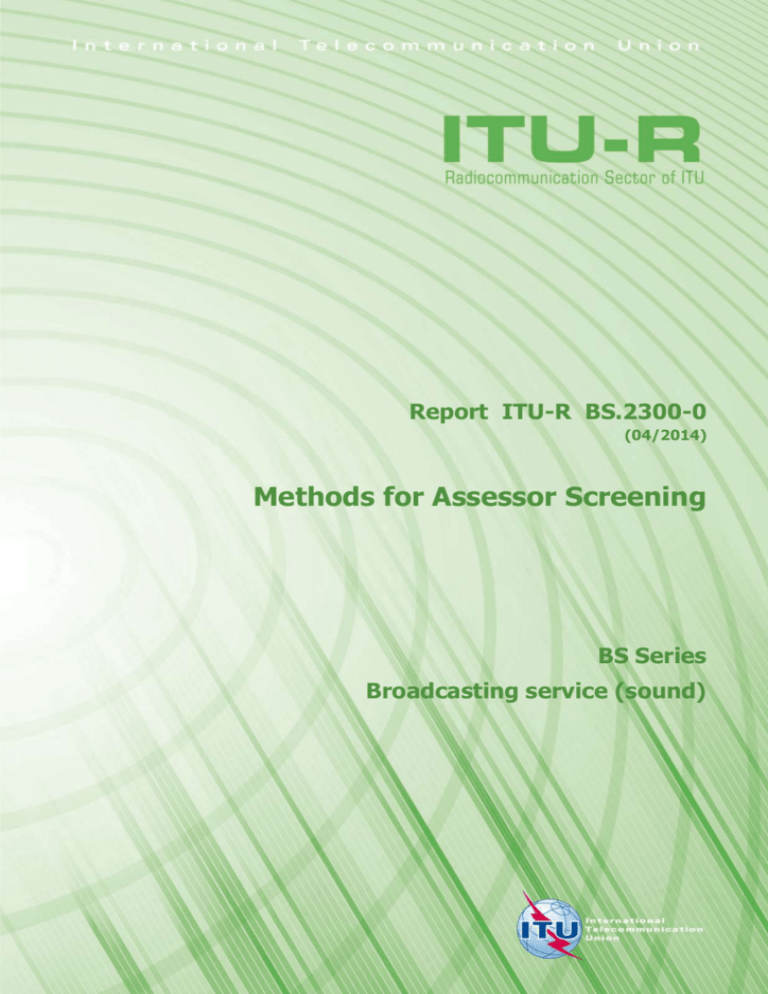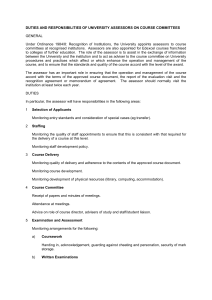
Report ITU-R BS.2300-0
(04/2014)
Methods for Assessor Screening
BS Series
Broadcasting service (sound)
ii
Rep. ITU-R BS.2300-0
Foreword
The role of the Radiocommunication Sector is to ensure the rational, equitable, efficient and economical use of the
radio-frequency spectrum by all radiocommunication services, including satellite services, and carry out studies without
limit of frequency range on the basis of which Recommendations are adopted.
The regulatory and policy functions of the Radiocommunication Sector are performed by World and Regional
Radiocommunication Conferences and Radiocommunication Assemblies supported by Study Groups.
Policy on Intellectual Property Right (IPR)
ITU-R policy on IPR is described in the Common Patent Policy for ITU-T/ITU-R/ISO/IEC referenced in Annex 1 of
Resolution ITU-R 1. Forms to be used for the submission of patent statements and licensing declarations by patent
holders are available from http://www.itu.int/ITU-R/go/patents/en where the Guidelines for Implementation of the
Common Patent Policy for ITU-T/ITU-R/ISO/IEC and the ITU-R patent information database can also be found.
Series of ITU-R Reports
(Also available online at http://www.itu.int/publ/R-REP/en)
Series
BO
BR
BS
BT
F
M
P
RA
RS
S
SA
SF
SM
Title
Satellite delivery
Recording for production, archival and play-out; film for television
Broadcasting service (sound)
Broadcasting service (television)
Fixed service
Mobile, radiodetermination, amateur and related satellite services
Radiowave propagation
Radio astronomy
Remote sensing systems
Fixed-satellite service
Space applications and meteorology
Frequency sharing and coordination between fixed-satellite and fixed service systems
Spectrum management
Note: This ITU-R Report was approved in English by the Study Group under the procedure detailed in
Resolution ITU-R 1.
Electronic Publication
Geneva, 2014
ITU 2014
All rights reserved. No part of this publication may be reproduced, by any means whatsoever, without written permission of ITU.
Rep. ITU-R BS.2300-0
1
REPORT ITU-R BS.2300-0
Methods for Assessor Screening
(2014)
Summary
This Report contains a description of methods for the screening of experienced assessors in Report
ITU-R BS.1534 and related listening tests. The expertise gauge (eGauge) method describes in detail a means
of rapidly and robustly selecting experienced assessors. Software for this method is available on:
TABLE OF CONTENTS
Page
1
Introduction ....................................................................................................................
2
2
Technical descriptions ....................................................................................................
3
3
Example output and assessor screening..........................................................................
4
4
Results for inclusion in test Report.................................................................................
8
5
Source code.....................................................................................................................
8
6
Common listening tests data format ...............................................................................
8
6.1
Example data format ...........................................................................................
9
References ......................................................................................................................
9
7
2
1
Rep. ITU-R BT.2140-1
Introduction
Report ITU-R BS.1534 advises that experienced assessors be used in order to collect high quality
listening test data. This Report describes methods for the selection of experienced assessors. The
“expertise gauge” (eGauge) method [1] describes in detail a means of rapidly and robustly selecting
experienced assessors. Software for the method is available on:
This Report focuses upon methods for the screening of experienced assessors for usage with Report
ITU-R BS.1534 and related recommendations. The method seeks to efficiently identify experienced
assessors that are suitable for inclusion in data analysis based upon the following assumptions:
–
assessor experience is to be shown within an experiment (a pilot study or the main
experiment);
–
data from Report ITU-R BS.1534 experiments are to be treated as absolute in nature;
–
assessor experience is to be demonstrable based on a minimum of one attribute.
An experienced assessor is chosen for his/her ability to carry out a listening test. This ability is to be
qualified in terms of the assessors Reliability and Discrimination skills within a test, based upon
replicated evaluations.
The expertise gauge (eGauge) approach measures three performance characteristics, in relation to
assessor ratings as illustrated in Fig. 1.
–
–
–
Discrimination: a measure of the ability to perceive differences between test items.
Reliability: a measure of the closeness of repeated ratings of the same test item.
Panel Agreement: a measure of the closeness of ratings between a listener and the panel.
FIGURE 1
The four basic assessor differences in scale ratings. Letters A, B and C
represent the scores of three different systems
The method considers the overall performance of the assessor in the evaluation of all test stimuli
(systems and samples), excluding anchors of reference samples.
The three test metrics of discrimination, reliability and agreement are calculated based upon an
analysis of variance of the data. A non-parametric permutation test is then applied to each metric to
define a threshold of acceptability and provide a robust method for the performance categorization
of assessors within any given test. Based upon the analysis of discrimination and reliability
performance for test stimuli, it is possible to objectively quantify and establish what category an
assessor’s performance falls into, in accordance with ISO 8586-2 [3] (see Table 1).
Rep. ITU-R BS.2300-0
3
For the needs of Report ITU-R BS.1534, assessors with performance falling below the permutation
test level for both discrimination and reliability will be categorized as naïve, and as such can be
excluded from the test analysis. Assessor exceeding the permutation test level for both
discrimination and reliability may be categorized as selected or experienced assessors.
TABLE 1
Assessor categorization terminology based upon ISO 8586-2 [3]
Assessor category
Performance description
Assessor
Any person taking part in a sensory test
Naïve assessor
A person who does not meet any particular criterion
Initiated assessor
A person who has already participated in a sensory test
Experience assessor
(selected assessor [3])
Assessor chosen for his/her ability to carry out a sensory test
Expert assessor
Selected assessor with a high degree of sensory sensitivity and experience
in sensory methodology, who is able to make consistent and repeatable
sensory assessments of various products
2
Technical descriptions
The model described herein is an evolution of the original expertise Gauge (eGauge) approach
developed, tested and reported in [1].
The eGauge model proposed here has been improved in a number of ways. Primarily, the new
model is able to handle both 4- or 5-factor datasets as commonly encountered in Report ITU-R
BS.1534 tests. Typically 4-factor experiments comprise systems, samples, replicates and assessors.
5-factor experiments may have an additional factor, generically referred to as condition.
“Condition” may refer to important experimental characteristics such as bitrate or other parameters.
The method uses an ANOVA (analysis of variance) of the 4- or 5-factor data to calculate the three
performance metrics, namely, discrimination, reliability and agreement.
An unfolding methodology is applied on the data in order to reduce the number of factors in the
ANOVA model. From a 2-way (system, sample) or 3-way (system, sample, condition) ANOVA,
the factor/column system, sample and condition are merged to create a new factor: stimuli. The
factor stimuli is equivalent to:
System + Sample + (Condition) + System * Sample + (System * Condition + Sample * Condition +
System * Sample * Condition).
Therefore the explained variance of stimuli is actually the variance explained by the experimental
design.
In the following description the variables are:
–
k is a replicate between 1 and K;
–
i is a stimuli between 1 and I;
–
j is an assessor between 1 and J.
After the unfolding, the following values are extracted:
–
count K, the number of replicates;
–
calculate Xi the average value of each stimulus.
4
Rep. ITU-R BT.2140-1
The following calculation is run on each assessor:
–
compute a 1-way ANOVA in order to get the mean square error (MSEj) and the mean
square from the stimuli factor (MSSj);
–
calculate Xij the average value of each stimulus;
–
calculate the SPANj, the average standard deviation of a score given by the assessor j;
–
calculation of the sum of square of the Disagreement MSDj.
From these values, the reliability, discrimination and agreement are computed:
–
reliability j is the SPAN (average of all the SPANj) divided by the mean square error of
assessor j from the ANOVA model;
–
discrimination j is a F-value, it is the ratio between the MSSj and the MSEj;
–
agreement is the ratio between the SPAN and the MSDj.
The three metrics, reliability, discrimination and agreement provide an overview of the assessor
performance. A non-parametric permutation test [4] is then used as a test of significance. The
permutation test is computed using 150 iterations per assessor, in which the systems are shuffled per
assessor in each replicate for the calculation of the reliability and discrimination. This is repeated
for all assessors to calculate the permutation test level of the test.
For agreement, the data of one assessor are shuffled one at a time and compared to the overall panel
and this operation is iterated for each assessor to calculate the permutation test level of the test.
In practical terms the permutation test defines the so-called noise floor of the assessor performance
for reliability and discrimination metrics. Below this level, assessor performance is equivalent to
random ratings, which only degrade the quality of the data and the estimates of central tendency.
3
Example output and assessor screening
The eGauge method provides four graphs as output. The three metrics (discrimination, reliability
and agreement) are plotted as bar graphs for each assessor (Fig. 5). The black line in each plot
indicates the non-parametric permutation test level. Additionally, a summary scatter plot is provided
of reliability versus discrimination (see Fig. 6). This Figure has four quadrants delineated by the
permutation test levels for the two eGauge metrics: reliability and discrimination. The quadrants are
illustrated in Fig. 2 and explained in Table 2.
Rep. ITU-R BS.2300-0
5
TABLE 2
Description of quadrant definitions and actions for eGauge reliability
and discrimination scatter plots
Quadrant
Assessor performance description
Categorization
Action
Quadrant 1
Good discrimination,
Poor reliability skills
Naïve assessor
Training required
Exclude from analysis
Quadrant 2
Poor discrimination,
Poor reliability skills
Naïve assessor
Training required
Exclude from analysis
Quadrant 3
Poor discrimination,
Good reliability skills
Naïve assessor
Training required
Exclude from analysis
Quadrant 4
Good discrimination,
Good reliability skills
Experienced (or
selected) assessor
Include in analysis
Assessors in the top right of quadrant 4 show a high degree of expertise in Fig. 2.
FIGURE 2
Quadrant description for eGauge scatter plot of reliability versus discrimination.
The permutation test level for the two metrics provides the delineation between quadrants
Discrimina on
Expert
Assessors
Training required !!
Experienced
Assessors
Q1
Q2
Q4
Q3
Naive
Assessors
Training required !!
Noise
Reliability
The agreement plot is informative regarding the degree of agreement between assessors. Assessors
below the permutation test level are in poorer agreement with the panel mean compared to assessors
above the permutation test level.
Once the data has been analysed, it is possible to select and report suitably experienced assessors
for inclusion in the final analysis. Assessors whose discrimination and reliability ratings exceed the
permutation test level (defined by the dark line in Figs 3 and 4) shall be considered as experienced
assessors for the purposes of the experiment under analysis. Assessors are categorized as naïve if
their rating on either or both reliability or discrimination metrics fall below the permutation test
threshold and will be excluded from the analysis.
6
Rep. ITU-R BT.2140-1
FIGURE 3
eGauge assessor discrimination plot
FIGURE 4
eGauge assessor reliability plot
Rep. ITU-R BS.2300-0
FIGURE 5
eGauge panel agreement plot
FIGURE 6
Combined eGauge assessor reliability and discrimination plot
7
8
Rep. ITU-R BT.2140-1
4
Results for inclusion in test report
All four output plots may be provided in the test report to demonstrate the degree of assessor
experience. Only data from qualified experienced assessors in pre- or post-screening should be
included in test data analysis. Assessors should be anonymised in the test report.
If pre-screening pilot experiment was performed, a full description of this pilot study should be
provided to demonstrate its validity of the stimuli for the screening and categorization of assessors
for the main experiment.
5
Source code
The stable source R (for R version 3.0.1) code for eGauge is available on:
The open source R environment for statistical analysis is available from: http://cran.r-project.org
6
Common listening tests data format
The data structure proposed here should be sufficiently generic to allow for analysis of data from
Report ITU-R BS.1534 test data. Additionally, the format allows for import to all commonly
employed statistical analysis tools and environments, such as SPSS, SAS, Matlab, XLStat, R, etc.
Data shall be stored in a tab delimited text file (.txt) and will employ a “.” as the decimal separator.
This format can be directly imported into Microsoft Excel as well and other common statistical
analysis tools for editing and manipulation.
Each row should be the evaluation of one stimulus by one assessor for one replicate.
The first row of the file shall contain the column labels for all the data, according to the following
definitions:
TABLE 3
Common listening tests data format structure
Header
AssessorID
SystemID
SystemLabel
SampleID
SampleLabel
ConditionID
Condition
Label
Replicate
Rating
Description
Assessor
identification
System
number
Test system
name
Sound sample
number
Sound sample
name
Optional
additional test
factor number
Optional
additional test
factor name
(e.g. bitrate)
The replicate
number
Assessor
rating
Type
Text string
Numeric
Text string
Numeric
Text string
Numeric
Text string
Numeric
Numeric
Use 1 to n
Use “.” as
decimal
separator
Details
Reference = 0
Anchor = –1,
–2, etc.
Use 1 to n
Use 1 to n
Column header labels are case sensitive.
The SystemID of the reference should be 0 and the SystemID of the anchor should be –1. In the
case of additional anchors, these will be labelled with a negative SystemID, e.g. –2, –3, etc.
If one or more factors are not used in the experiments they should however be in the data. The
numeric ID and the label should then have only one level. See the factor “condition” in the
following example (see Fig. 7).
Rep. ITU-R BS.2300-0
6.1
9
Example data format
FIGURE 7
Example common listening tests data format, when imported into Microsoft Excel (.xls).
7
References
[1]
G. Lorho, G. Le Ray, N. Zacharov, “eGauge – A Measure of Assessor Expertise in Audio Quality
Evaluations” Proceeding of the Audio Engineering Society 38th International Conference on Sound
Quality Evaluation, Piteå, Sweden, 13-15 June 2010.
[2]
P.B. Brockhoff, Statistical testing of individual differences in sensory profiling. Food Quality and
Preference 14(5-6), 425-434, 2003.
[3]
ISO 8586-2, Sensory analysis – General guidance for the selection, training and monitoring of
assessors – Part 2: Experts. International Organization for Standardization, 1994.
[4]
G.B. Dijksterhuis and W.J. Heiser, The role of permutation tests in exploratory multivariate data
analysis, Food quality and preference 6, 263-270, 1995.
[5]
D.S. Moore, G.P. McCabe, Introduction to the Practice of Statistics, W.H. Freeman &
Company, 2006.
______________






